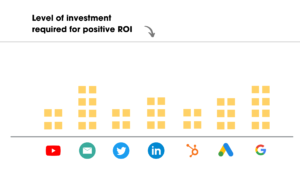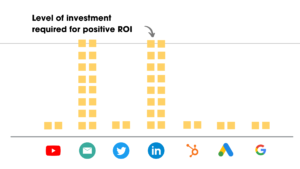You haven’t heard of ‘content creep’. But if you work in marketing, you’ve definitely experienced it.
Let me paint you a picture.
You’re a marketer at a fledgling SaaS company. Like every company, you have a website.
You want more people to visit your website, so you start a blog. But no one knows your blog exists, so you create a Twitter account. While you’re at it, you fire up a LinkedIn account as well.
Within a few weeks you’re getting a slow but steady stream of visitors. Result! 😀
But what are you going to do with those visitors? You should probably try and grab their email address, right? So you start a weekly newsletter.
Now you’ve got a blog, a newsletter, Twitter and LinkedIn. Yeah, you’re busy, but your workload is manageable and your traffic is growing.
Then your founder notices a competitor just launched a series of webinars. “Can we do webinars?” She asks at your next stand-up.
You know you don’t have time. But you don’t want to look like you’re avoiding work, so you say sure, why not.
So now you’ve got a blog, a newsletter, Twitter, LinkedIn and bi-weekly webinars. You’re having to manage five different content calendars, as well as creating all of the imagery these channels demand.
This is it, you tell yourself. No more.
Then someone from sales pipes up and says their last job used to get nearly all of their leads from SEO. You’ve already got a blog, so why don’t you start creating content for SEO as well?
You explain that SEO is complex and you’re already struggling to keep up with everything you have to do. But the decision gets made and SEO content is added to your to-do list.
So now you have way more work than you can handle. And you don’t have the time you need to do it well.
You used to spend hours researching and writing unique and interesting blog posts. These days you’re hitting the word count as quickly as you can. Your weekly newsletter has become bi-weekly and the last one you sent had a typo in the first sentence. You’ve stopped creating content for social media and started posting links because it’s quicker.
Worst of all, your traffic and leads are drying up. You know why – it’s because your content sucks. It’s because you’re trying to do too many things at once.
THIS IS CONTENT CREEP. AND IT’S THE WORST.
In this post, I’m going to look at why content creep happens and how you can avoid it by being the best in your industry at just one thing.
But first, let’s look at how we got in this mess…
Steal Our Playbook
We’ve spent years iterating and refining our proven growth playbook.
Now we’re giving it away for free.
Get it now
The trap of ‘multi-channel marketing’
As marketing became more digital and increasingly fragmented, a new buzzword appeared – multi-channel marketing.
The idea was that since customers are active on multiple online channels, brands should be too. The greater your brand’s surface area, the more likely you are to come into contact with buyers.
Every buzzword has more or less the same lifecycle. It gets coined, talked about a lot, then disappears. Either because people realise it’s rubbish or it becomes so ingrained in our thinking that it becomes the norm.
Multi-channel became the norm. Talking about multi-channel may seem passé now, but everyone thinks this way without realising it. And this is a problem, because when you do something without thinking about it you start to overlook the downsides.
And there are big downsides to multi-channel when you think in terms of ROI rather than ‘best practice’.
Marketing budgets are finite. The more channels you have, the less time and money you have to spend on content. Anyone who’s run a successful content operation knows there is a threshold of time, effort and money you need to put into your content before you turn a positive ROI on any channel.
Investing small amounts of money in lots of low-quality content will have a negative ROI, no matter how many channels you do it across. In fact, by doing it across multiple channels, you’re multiplying the negative impact.

This dynamic isn’t exclusive to marketing. It’s universal. Let’s say you need a car but you’re short on cash, so you get an old model with lots of miles on it. It breaks down all the time, is inefficient and needs to be scrapped within a year. That’s a negative ROI purchase despite being very cheap.
You learn your lesson and buy a car that’s three times the price of the last one but never breaks down, is extremely fuel-efficient and after two years you sell it on for 50% of what you originally spent. That’s a positive ROI purchase despite being more expensive.
Replace ‘buying a car’ with ‘opening a restaurant’ or ‘buying IT equipment’ and you get the same story
Returning to marketing, and this is the critical flaw in a multi-channel approach, having a mediocre presence on any channel will usually have a worse ROI (negative) than not being there at all (neutral).
Starting a YouTube channel is free and easy. Creating high-quality video on a regular basis is not. In fact, it’s really hard. Same goes for every channel you can think of.
Even Twitter, which a lot of B2B marketers don’t take that seriously, is hard to do really well. And unless you do it really well, you’re probably not making money from it.
By dividing up your time and your budget, multi-channel drives your marketing ROI through the floor, because you don’t have the time to do things well.
This effect is compounded when you combine it with another piece of ‘best practice’, which is that it’s important to publish something, anything, on a regular basis.
Not publishing stuff makes people uncomfortable. It makes marketers uncomfortable because we want to look productive. It makes managers uncomfortable because they want their staff to be doing stuff.
Intuitively, the more channels you have and the more stuff you publish, the better your results will be, right?
No. If you have a finite amount of money and time, it’s the opposite.
The less channels you try to focus on, the less content you need to make. The less content you need to make, the more time you have. The more time you have, the better your content becomes and the more likely you are to break through the threshold of quality required to turn a positive ROI.

Basically, multi-channel atomises your time, attention and creativity in the same way that multi-tasking wrecks your productivity. Like a lot of buzzwords it’s great on paper but not in practice.
So what should you do instead?
The obvious answer is to do less. But I’d take it one step further than that.
Set out to be the best in your industry at just one thing.
That may sound bold, but in my experience, if you don’t set out to be the best at something you won’t make it into the top ten. And setting out to be the best at something will focus your attention.
Obviously, that channel won’t be the only thing you do. Modern marketing is always going to be multi-channel to some extent. But make one channel your priority and use your other channels to support that ambition.
There’s a big difference mentally between doing five things at once and doing one thing in five different ways. From your strategy through to your reporting, having one priority channel makes your marketing more focused and coherent. This is the basis of the ‘One Metric that Matters’ approach to growth outlined in Lean Analytics.
Where should you focus your efforts?
That’s a big question and not one that I can answer in the final sections of an already long and rambling blog post. But I will say this…
Email, SEO and PPC consistently lead ROI comparisons across different channels. If I was trying to decide what channels to prioritise I’d start there with one important caveat…
They only have the best ROI when you do them well.
A great channel used poorly will perform poorly. A Stradivarius violin played by an amateur will sound bad. The question I’d ask is…
How can you allocate your resources so you break through the minimum threshold required to have a positive ROI for at least one of these channels and ideally a combination of them.
I’ve been thinking about ‘Content Creep’, why it happens and how to fix it for quite a while now. I’ve really enjoyed writing these thoughts up and I’m interested to hear what you think.
Have you experienced Content Creep? Do you totally disagree with everything I’ve said?
In either case, I’d love to hear from you. You can find me on LinkedIn or Twitter (I check Twitter more often).
Thanks for reading. 😀




